Your cart is currently empty!
The Beginner’s Guide to Divination
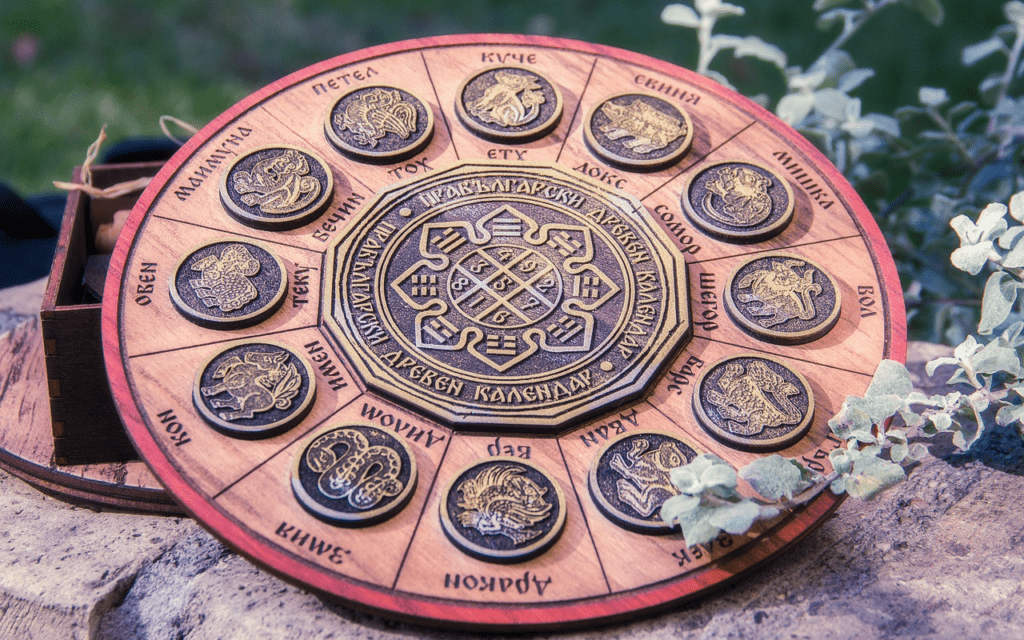
No matter where you find yourself on your path, it’s a good idea to incorporate divination into your practice. It can provide a level of safety and guidance that you may not realize is necessary until the moment something unprecedented happens. In addition, divination can provide, for the more experienced, ample passages of communication between the physical realm and the realms that lie beyond. Today, I’ll be introducing you to many of my favorite methods of divination and explaining what each method can be best used to help you out along your spiritual journey.
What Is Divination?
Divination, as I define it, is the practice of gathering information or receiving messages – sometimes, but not always, regarding future events – via psychic or otherwise supernatural means. This information may come from within or without, from our Higher Self, our subconscious, the Divines, other external entities or energies, a collective pool of consciousness, or, if your beliefs are like my own, any of the above that you choose to tap into. It can be used on a regular basis to gather insight and plan accordingly, prior to spell work or ritual work to predict potential outcomes and determine what, if anything, may need to be tweaked, or to simply gather information as wanted or needed.
From the perspective of an experienced witch, I would highly recommend that all practitioners of any level practice divination regularly and, particularly, prior to ritual or spell work in order to receive insight into potential outcomes and any changes that may need to be made to avoid inadvertent negative outcomes. Though this is an extreme example, you wouldn’t want the result of a money working to be the sudden inheritance of a loved one – and this is merely one of many negative, albeit less devastating, potential examples. Divination can show you exactly where your focus needs to be to avoid these things.
Before we go any further, however, it is also worth noting the limitations of divination (and how to circumvent them). First, it’s necessary to recognize that much of divination falls on the reader’s interpretation. This is why paid readers may not all deliver the same satisfaction with results. Both the selection of lots – if lots are indeed what you are using – and the interpretation of them rely heavily on intuition, discernment, and trust for our abilities. Second, when using divination for future forecasting, I am not of the belief that the future is set in stone. Rather, I believe this sort of divination takes the path you are already on and lays out your current trajectory. What lies beyond that is advice, options, and alternate possibilities. Understanding that, let us proceed.
Cartomancy
Perhaps the most well-known form of divination today is that of card divination – with tarot being the popular subset of such a practice. Cartomancy, or card divination, is done by way of drawing one or multiple cards and then pulling meaning from the card(s) you’ve drawn. When you lay these cards out to form a pattern or paint a timeline, this is known as a spread – and in the case of a spread, the cards are thought to all work together and/or play off of one another.
There are many methods of drawing cards when using them for divination, but my method is quite simple: Shuffle and draw intuitively. I don’t do reversals (which we’ll get into shortly). I don’t fan the cards out in front of me. I simply shuffle, using the repetitive motion as a means of getting into a meditative headspace, and stop only once I feel called to. At times, there will be a card that “jumps out” of the deck, which I will then add to my spread. Other times, this “jumping out” is simply an accident. For this, I use my intuitive discernment.
Moving onto specifics: Let’s talk tarot. With 78 cards in total (22 of the Major Arcana and 56 of the Minor Arcana) all with very specific meanings and a long-standing history to back it up, tarot may just be the most popular form of divination there is. Each card is dressed with a variety of rich symbolism pulled from alchemy, astrology, numerology, and Kabbalah, with the Rider-Waite deck providing the most clear presentation of these symbols. For a quick reference, I’ve compiled a cheat sheet below, but should you like to take a deeper dive into the symbolism of the tarot, I’d like to point you in the direction of my favorite resource, Biddy Tarot.
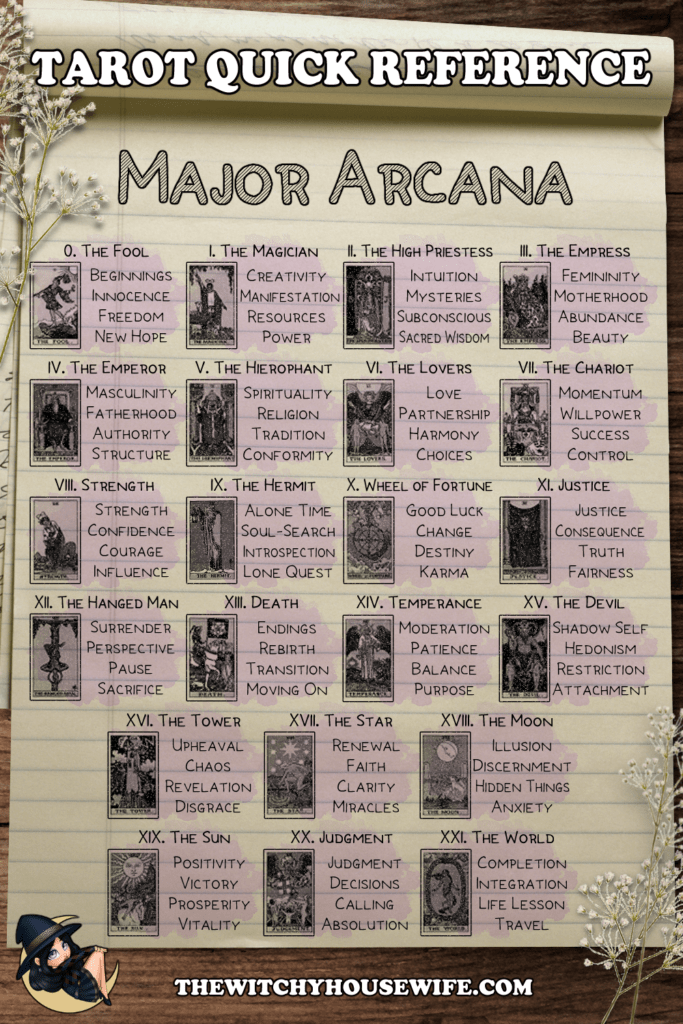

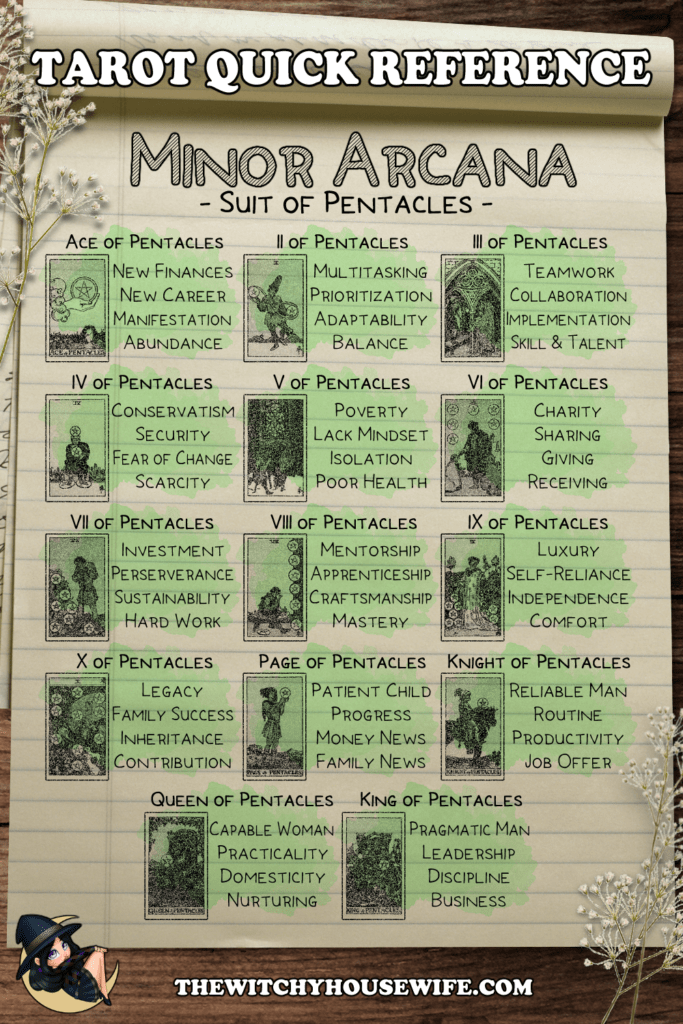
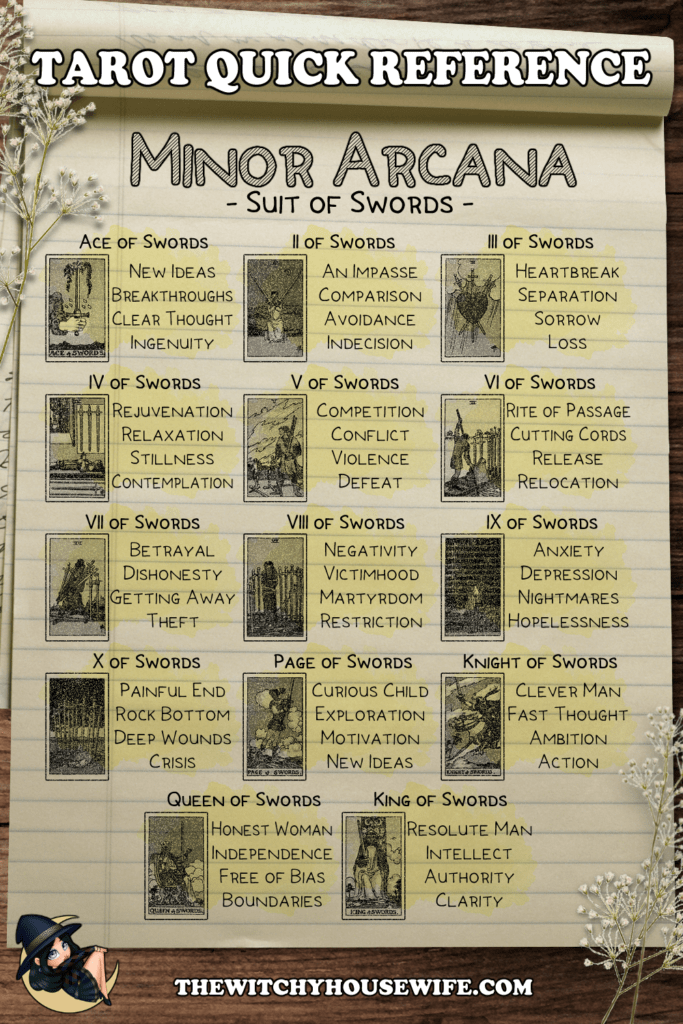
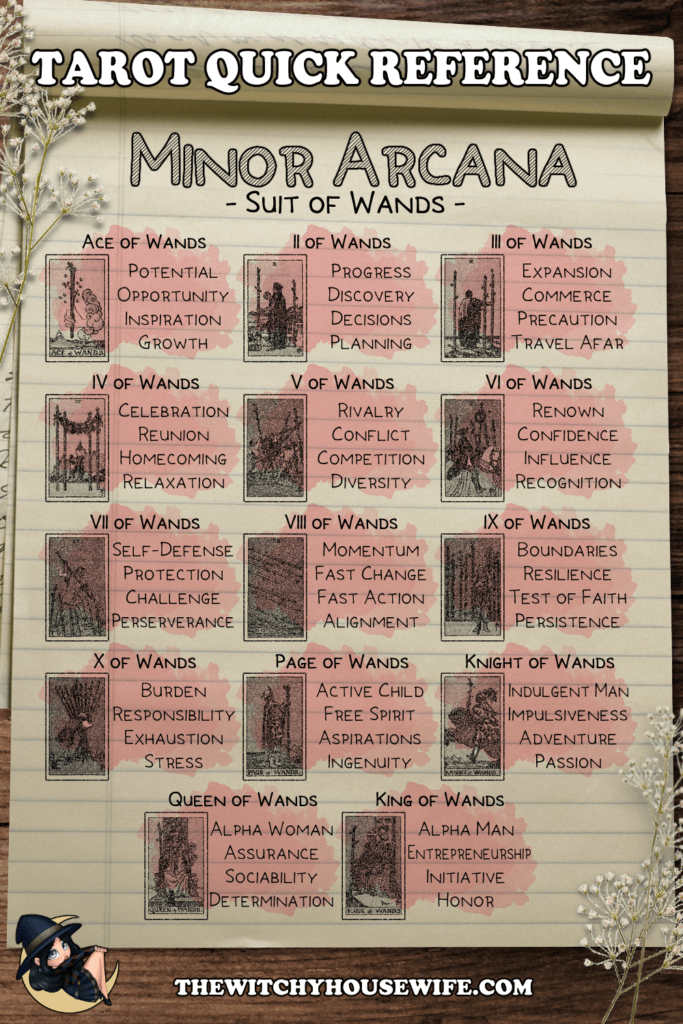
Similar to the tarot is Lenormand, a 36-card deck named after French fortune-teller, Marie Anne Lenormand. Though not my preference, it is considered by many to be the simpler and more practical form of cartomancy, given its truncated collection of cards and its delightfully straightforward meanings. The website, Lenormand Reader, offers a thorough yet easy-to-digest guide to this form of divination here, should you feel called to it.
If tarot and Lenormand feel too restrictive, consider looking around for an oracle deck, which is a bit more open-ended of a concept and typically carries symbolism related to a specific theme or concept upon which the deck is designed. In an oracle deck, there is no set amount of cards nor is there a specific set of meanings to be applied, and despite typically being sold alongside booklets which explain the unique meaning of each card, I find that reading them strictly on intuition yields best results. In fact, using a combination of tarot and oracle cards is an integral part of my practice and both my personal and professional reading process.
Finally, the cheapest means of cartomancy: A simple playing card deck. Interestingly, it’s thought that divination may have even been the initial purpose of the traditional playing card deck, and the symbolism – as with tarot and Lenormand – is fairly straightforward. Café Astrology, one of my favorite websites, has a fantastic guide on this form of cartomancy.
Looking at cartomancy in general, there are two things I’d like to address a bit further: Intuitive reading and reversals. While you can certainly take surface symbolism for what it is in systems like tarot and Lenormand, reading cards intuitively first can take your interpretations a step further – and I am of the belief that anyone considering offering readings as a paid service should first become comfortable in doing so. As for reversals, if you are someone who wishes to use them by the book, they are typically (but not always) read to mean the opposite of the meaning ascribed to them upright. Otherwise, if you’re like me, connotation of meaning can also simply be read intuitively, as with every other aspect of cartomancy.
Cleromancy
Cleromancy is a form of divination in which a seemingly random drawing or casting of lots is used to determine a prophecy or outcome. In cleromancy, lots with ascribed meanings can be thrown, set out in a pattern, or simply drawn from a container of choice – typically, a small bag or jar. Currently, rune casting stands to be the most popular format of cleromancy, with the Elder Futhark alphabet being the most commonly used set of runes to accompany the practice. You can find a very basic breakdown of the divinatory meanings of the Elder Futhark runes here, but given the Hellenic slant in my practice and the fact that these sorts of runic alphabets are said to be heavily connected to regional gods, I tend to use the Psephoi (translating to tiles representative of votes) featuring the Greek alphabet myself. The idea is quite similar to that of Elder Futhark rune casting but connected, instead, to the Hellenic pantheon rather than the Norse pantheon. To avoid this article becoming novel-length, I’ve provided the meanings in this neat little graphic below:
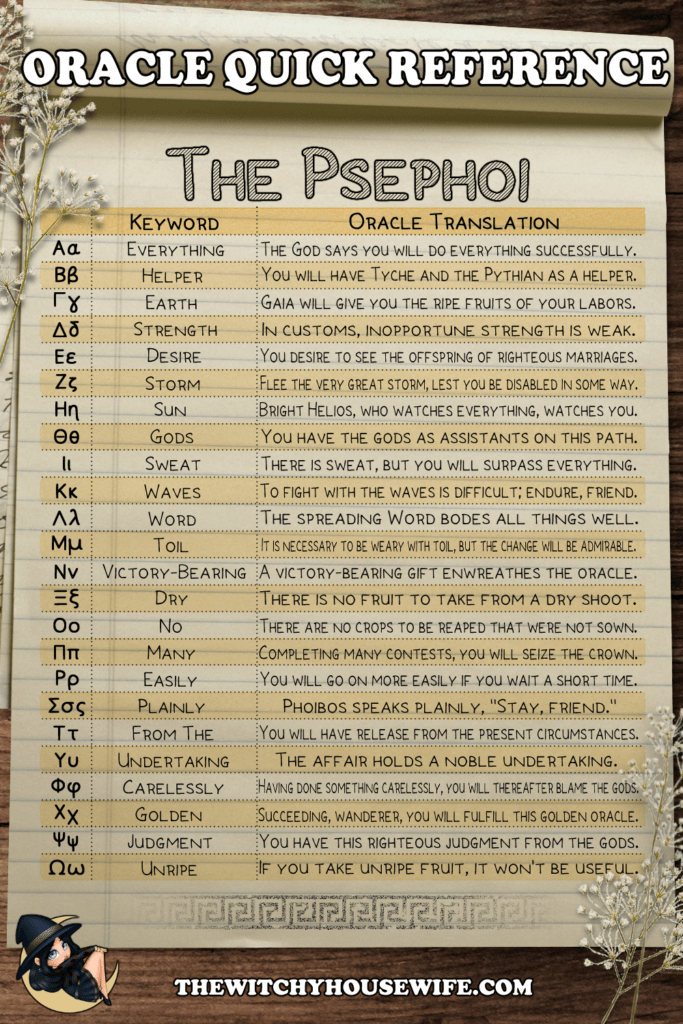
A less popular but more open-ended version of rune casting is by use of the Witches Runes. With 13 runes in total and much less history to learn (as history on this particular set of runes is incredibly sparse), it is much less overwhelming to get into if you are a beginner to the art of rune casting. If you find yourself drawn to it, this article breaks down the meanings pretty well.
Moving onto more complicated forms of cleromancy, we have the I Ching (translating to Book of Changes), an ancient Chinese divinatory text considered to be among the classics of Chinese literature. Admittedly, I am not terribly familiar with the piece nor the practice, but it is a notable enough one that I thought to include its mention for those who might feel called to it, and while there’s no better source than the book itself, the website No2Do provides a lovely study guide.
On the other hand, if you want a simpler method of cleromancy, there is Astragaloi (referring to ankle bones) divination, which utilizes the casting of bones or dice. As with oracle decks, Astragaloi or dice sets can be much more varied in meaning. In the case of the classic D6 (or any other die in your tabletop dice set), meanings could be as cut-and-dry as those ascribed to numbers within numerology, or they have the potential to be determined entirely by the caster.
Pendulums & Spirit Boards
For a much more straightforward form of divination, the unassuming but mighty pendulum – a small, weighted object (typically, a pointed crystal or metal) attached to a string, chain, or cord – is a useful tool. At a very basic level, it can be used to answer binary questions – oftentimes, yes or no – by way of “programming” it. This just means to hold it still and ask it to show you the gesture it associates with one of the two answers you are seeking. For me, I find that “yes” is always a vertical swing, “no” is always a horizontal swing, and anything else is uncertainty or that the target of communication is unable to answer for whatever reason at this time. This may be different for you, so it’s always good to establish prior to seeking answers to questions.
Another classical use of the pendulum is what is known as dowsing, a form of divination used to locate ground water, underground valuables, gravesites, energetic pools or ley lines, or lost items. You may be familiar, as well, with the concept of dowsing rods, which serve the same purpose. While this would traditionally be done outdoors, a map may also be used. In either case, the process is simple: The pendulum (or dowsing rod) would gently tug you in the direction of the item or area you seek.
In that same vein, in the case of a spirit board (or ouija board), a slate or surface displaying various letters on numbers intended for communication with spirits, a pendulum may be used in lieu of a planchette (the little wooden or plastic wayfinders that typically come with them). Personally, I find that they work much better.
In my practice: I personally utilize three different pendulums for three different purposes. For general purpose use, I use a pendulum of rose quartz. Rose quartz holds the multipurpose qualities of quartz while erring on the side of positive, loving, even healing energies. Therefore, it has a quality that, to me, is naturally safer for most pendulum work. It’s also relatively easy to find. For communication with spiritual beings of any kind, I use a pendulum of copper. Copper is an amazing conductor of spiritual energy, thus making it easier, in my understanding, for spiritual beings to communicate through it. Depending on the spirits you work with, it may require more frequent cleansing. Finally, for workings related to the energy body, I use a pendulum of orgonite filled with crystal chips corresponding to the chakras. The topic of orgonite is one for another time, but this tool has served its purpose beautifully for me.
Now, before we move on, a little bit more on spirit boards: Courtesy of the horror movie industry and our natural fear of the unknown, spirit boards tend to have a bit of a reputation, but I want to assure you that they are no more dangerous than any other form of spirit communication. This isn’t to say that we can’t run into spirits who intend to cause us harm, but rather, it’s a process more akin to speaking with a stranger in the street. If you keep your wits about you, pay attention to red flags and your surroundings, and are equipped to defend yourself should you have to, more often than not, you’ll make more friends than you will enemies.
Various Forms of Scrying
Scrying is a form of divination which involves gazing into a reflective or transformative medium with the intention of discerning symbolic and/or prophetic imagery. You may be familiar with the iconic crystal ball gazing of Hollywood portrayals of witches and fortune tellers. While the effect of this practice has been highly glamorized in such portrayals, it’s not all that far off. When scrying in this manner, the room is darkened and typically only lit by candle. The seer then relaxes and defocuses their eyes, allowing imagery to form in the fuzzy reflections in front of them. In the case of a crystal ball scrying, a sphere of obsidian, onyx, or any opaque reflective black material is preferable. You may also prefer to use a reflective blackened mirror or a black bowl filled with water in its place.
Another interesting method of scrying is through the use of an actual mirror – also called catoptromancy. This is useful for both work on yourself and for work with spirits, so do be mindful of your intention going in. For example, in the case of self-exploration, you may gaze into your own eyes and watch as your defocused features shift over time, revealing more about your internal world. For spirit work, on the other hand, you would defocus entirely, focusing mainly on your peripheral vision and asking that certain spirits come into view and reveal themselves in the reflections. For best safety practice, I would, of course, recommend a dedicated mirror for this practice.
There are methods, however, that do not necessarily require maximum darkness. Such is the case with two of my favorite forms of divinatory gazing: Aeromancy, or sky and cloud gazing, and capnomancy, or smoke gazing. In my practice, I use the former to discern local ecological health, receive insight on local happenings, and to sightsee local air spirits, and I use the latter for visual communication with various deities and entities I may interact with. If, on the other hand, you feel more drawn to the other earthly elements, hydromancy, or water gazing, or pyromancy, or fire gazing, may be more up your alley. All of the aforementioned practices may be done in any degree of lighting, permitting that you are able to make out the visuals presented in front of you.
Dream Interpretation
Oneiromancy is a form of divination that involves the recall and interpretation of dreams. As the subconscious is the pilot in most dreams, this leaves open an incredible playground for communications and insights sans barriers and criticisms of the conscious, waking mind. In other words, many messages that come through this channel will be presented without logical interference – but for anyone interested in this form of divination, the first and likely most difficult step for many is to regularly be able to recall your dreams in the first place.
There are two simple steps you can incorporate into your daily routines which can help you begin to recall more detail from your nightly excursions: Setting a simple intention before bed to remember your dream(s) from throughout the night and keeping a dream journal at your bedside for immediate recording upon waking. Even a quick, “I don’t remember,” or vague impressions of feelings and emotions can help cue the subconscious to start storing these dream events with your more “reachable” memories, and over time, you will find your ability to recall dreams improves quite naturally.
Another benefit of keeping a dream journal is the ability to review a wide selection of dreams over a longer period of time. You may find repeating symbols, themes, or patterns present which may in itself offer deeper insights, but in addition, awareness of these symbols can help expand your nightly workings by revealing potential anchors to carry you into lucidity.
Astrology & Numerology
Astrology, a form of divination utilizing the interpretation of positions of certain celestial bodies at a given time, has become increasingly popular in recent years, largely as a sort of personality test, as people seek ways to better understand themselves and make sense of the crazy world they find themselves in. Beyond the popular sun, moon, and ascendant signs, however, is a full and complex mapping of stars, planets, and calculations that reveal much deeper insights regarding your life’s natural trajectory and the potential struggles that may arise in fighting it. For a deeper look into astrology – and much more information on the topic than I can provide in this article – feel free to check out my favorite astrology website, Café Astrology. If you’d prefer a quick reference, have a look at the basics of natal chart interpretation below:

Beyond the basic components of astrology, there are what are known as the Greek Lots, also called the Arabic Parts, which are calculations between various points on your chart that can reveal information regarding the relationship between them. As previously mentioned, I do not want to dive too deeply into any one topic in this article, so in this case, I will simply provide a quick reference for meanings and calculations should you like to practice with the concept:
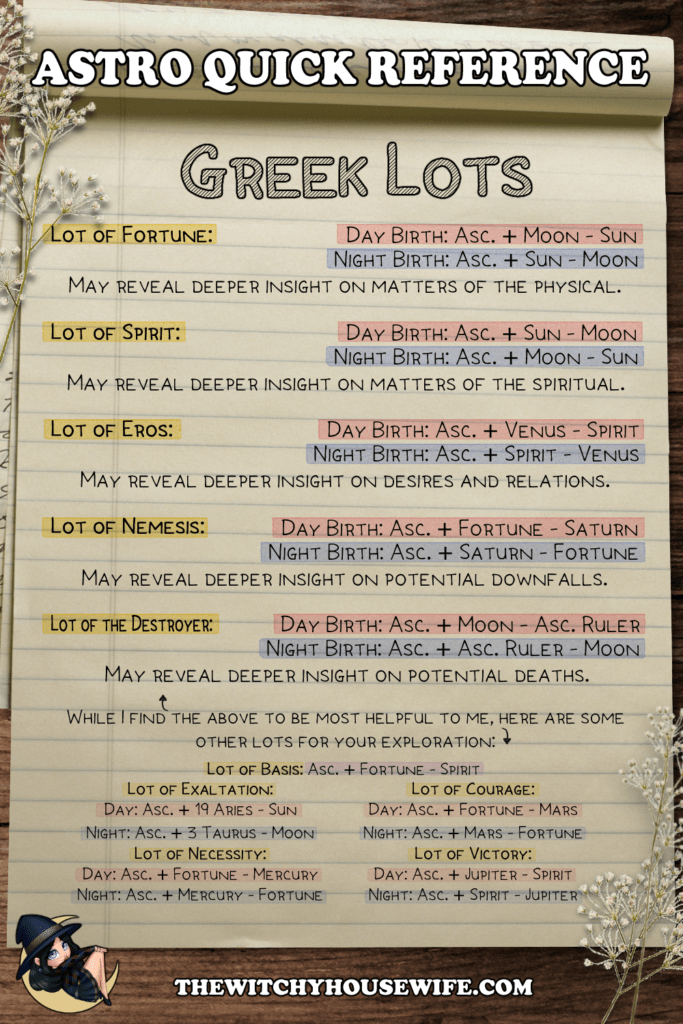
Finally, as this article concerns the future, I would be remiss to leave out the concept of horary astrology, which utilizes horoscopes (astrological charts – though the term is often also described to the interpretation of the chart) to reveal predictions and answers to various questions. As this is not a practice I incorporate into my own divinatory routines, I can point you to this article for a better explanation on it should your interest be piqued.
Beyond the western form of astrology mentioned above, there are other forms out there that you may feel yourself more called to, such as Vedic astrology (also Jyotish), which utilizes a different form of charting and calculation and places greater emphasis on the role of past lives in our current incarnations, or Human Design, which is a newer system combining elements of astrology, I Ching, and Kabbalah. These systems, as well, are not ones that I necessarily practice, so you may find the website, Vedic Astrology, to be a good resource on (obviously) Vedic astrology, and this article to be a good resource on Human Design.
Moving on now from astrology, numerology, the study of applying meaning to numerological values and finding patterns in the world around us utilizing those assigned meanings, is a tool which may be used in tandem with astrology to reveal even more insights into one’s path and purpose. Often, in this case, you’ll see these significant numbers calculated with names (also called onomancy) and birthdays, as in the reference below:
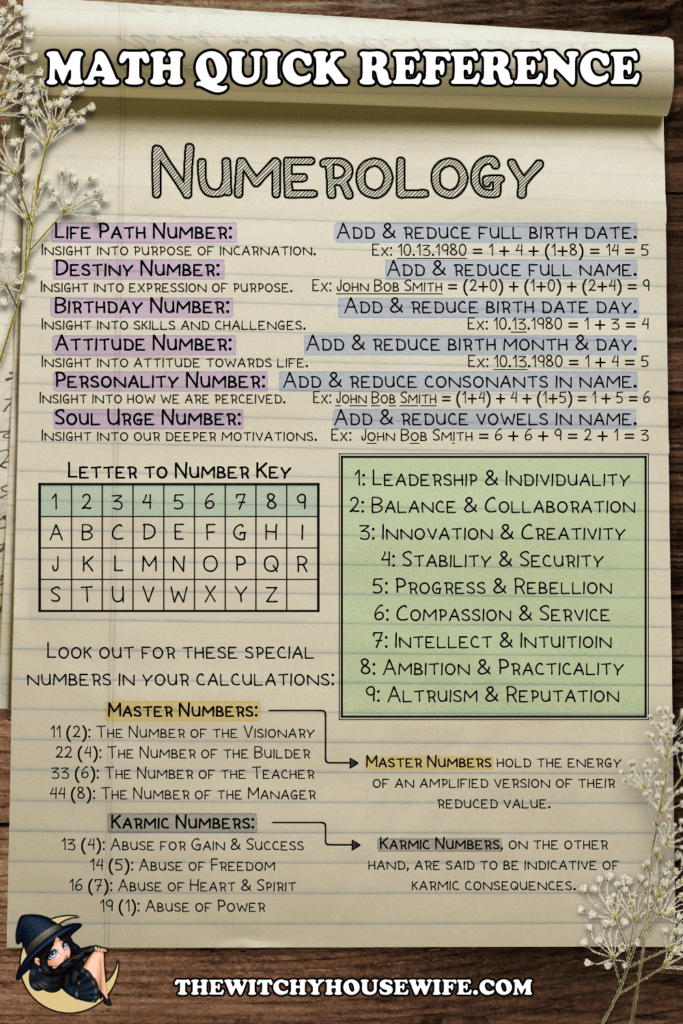
To apply this practice to life at large, you may be familiar with the Kabbalistic Gematria, a numerological system which assigns value to letters and words and compares them to other words of equal value. Kabbalistic Gematria, and its Latin counterparts, can be read about and calculated on the website Gematrix, but for those of us on a more Hellenistic path, there is Isopsephia – the same practice instead utilizing the Greek alphabet. In both cases, the values of the letters of a word are added together to assign a final numerical value to that word. Seeing as Gematrix does not offer a calculator for the Greek alphabet, I have provided a chart below:
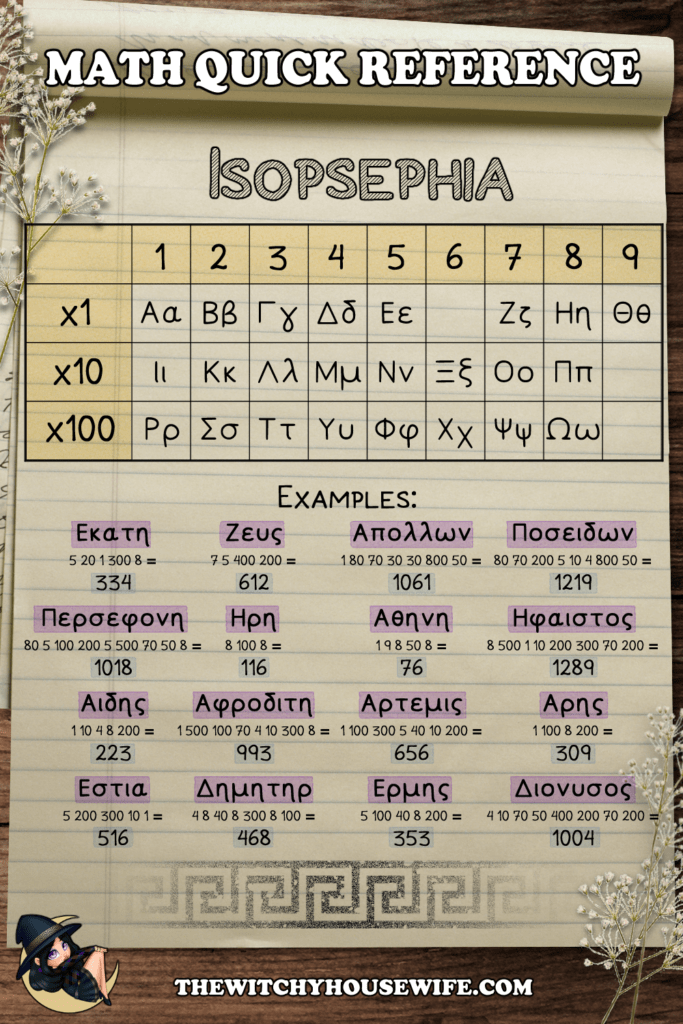
Other Divination Forms
There are, of course, many forms of divination beyond the ones I have covered here today. In fact, this article does not even scratch the surface of the multitude of divinatory methods out there, so as a courtesy to aid in your further exploration, I’ve compiled a list of some additional methods that may interest you and the practices they refer to:
• Trancework: The practice of going into a half-conscious trance state to receive visions via meditation. Going into trance is also useful for ritual and other forms of divination.
• Channeling: The practice of serving as a vessel for communication with spiritual beings, such as with oracular messages, mediumship, and automatic writing (or psychography).
• Palmistry: The practice of interpreting the markings and patterns which naturally occur on one’s palm. Also called palm reading and chiromancy.
• Tasseomancy: The practice of interpreting the patterns left behind in tea leaves, coffee grounds, or wine sediment.
• Geomancy: The practice of tossing soil, rocks, or sand to form patterns which are then interpreted. This can also refer to markings that are found organically in the earth.
• Ornithomancy: The practice of observing the quantity and/or behavior of birds to reveal divinatory messages, information, and/or insight. Also called augury.
• Bibliomancy: The practice of using a seemingly random selection or passage from a book to reveal divinatory messages, information, and/or insight.
• Rhapsodomancy: The practice of using a seemingly random selection or verse from a poem to reveal divinatory messages, information, and/or insight. Lyrics may also be used.
• Necromancy: The practice of calling upon and communicating with spirits for divinatory purposes. Often, however, it is attributed to the idea of reanimation of the dead.
Everyday Divination Practices
Signs can be found anywhere as long as you are open to them. Imagery, numbers, or symbolism that catch your attention (especially if it is repeating) in your day-to-day life may turn out to be a significant intuitive tug courtesy of your Higher Self. These symbols should be read intuitively, as their meanings can be unique and significant to you more than the pre-established symbolism engrained in the subconscious of the human race at large.
On the other hand, discernment is important, and not everything is necessarily a “sign”. For what it’s worth, I tend to believe that if you truly feel you are heading in the right direction, you probably are, but for safety and reassurance, the divination methods I outlined in this article maybe helpful for you on your path. For magick practitioners and spiritual experience seekers, a divination practice is especially helpful to ensure that you don’t run into any accidental, unwanted, or otherwise negative outcomes. Regardless of how you choose to incorporate it – or if you choose to incorporate it at all – do your best to take care of yourself and have a blessed journey as you continue to uncover the mysteries of life and this strange and funny existence we occupy.
Ready to take the next steps on your spiritual, mystical, or magick path? Check out my Digital Grimoire which offers a plethora of information for beginner and intermediate practitioners and make sure to subscribe to The Witchy Housewife below to receive updates by e-mail whenever I release a new article. No spam – just updates. Love and blessings.
Affiliate Notice: Please note that some of the links within this article are affiliate links, and purchases from these places will go towards helping me keep this website afloat at no extra cost to you. Rest assured that the companies I work with are ones that I personally use and trust myself. Thank you for your support.
2 responses to “The Beginner’s Guide to Divination”
-
I am surprised that you made no mention of taseomancy – the reading of tea leaves. This method is open for much interpretation, as the symbols seen within the leaves can have historic meanings, but are also open to meaning much like an oracle deck.
-
Thank you for pointing this out! I went ahead and added a small thing to the end of the article, but I think I’ll end up reviewing all of my articles and refreshing them sooner or later, and I may add a larger section on it then. Thanks again! Blessings! 🙂
-
Support My Work

Has my work helped you on your journey?
Click the coffee cup to tip me on Ko-Fi.
Tips and donations are always appreciated.
Thank you for supporting independent creators and the preservation of human creativity. 💜

Leave a Reply